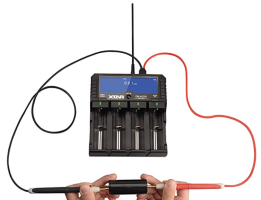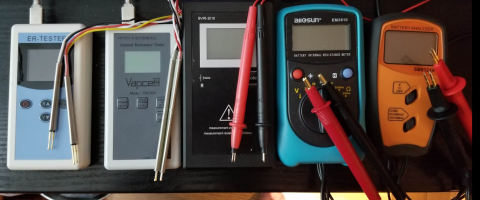Unfortunately I have not tested the XTAR VC8 but I did test the XTAR DRAGON VP4 PLUS.
The XTAR dragon has a seperate mode to test IR with a special set of probes and was relatively accurate just clumsy to use and really not designed for mass harvesting. Also at $84 it was kinda expensive for a mediocre Charger/Analyzer that will charge 4 cells at 1A but only discharge at 0.5A. It also has no cooling fans.
View attachment 26762
Your XTAR VC8 is just another( please don't take this the wrong way) mediocre Charger/Analyzer . You get what you pay for and in this case it is a Charger/Analyzer that thinks for you for $40. It will determine by the "IR" (Internal Resistance) of the cell at what amperage to charge, which is not adjustable as far as I know, and will only discharge at 300mA. Just think discharging a 3000mAh cell will take 10hrs...... No thank you.
View attachment 26766
Once you get good at harvesting you will want to have a bit more control over your testing procedure. The OPUS (with the fan mod) is probably the least expensive "proper" Charger/Analyzer you can get at $60. You get full 1A C/D/C and pretty accurate results. IR cannot be trusted on any slide style Charger/Analyzer no matter how expensive. I have The SKYRC MC3000 and its IR readings are also not quite up to snuff although better than most and it should be at $110.
View attachment 26763View attachment 26764
What do you consider low vs high ESR/IR? From now on AC IR
Also what chemistry are you using? ICR, INR or hybrid such as NCR, CGR, etc.
In your made up example you show cells in a range of 22mΩ to 15mΩ a 7mΩ difference between high and low. Depending on how many cells you have in parallel that can be a significant issue. In your example if using 3 cells I wouldn't have more than a couple of (2) mΩ difference between cells and certainly all cells within ≈100mAh of capacity difference. Once you expand your parallel pack cell numbers to 10 or more those values can be "fudged" a bit without too much of a problem. Although I would still prefer to see all cells in all packs as close as possible to each other in both IR and mAh as this makes for an optimally balanced battery and will require very little maintenance.
Also for successful harvesting and determining at first touch if a cell will be good or not, as
@floydR mentioned get an YR1035+ or my favorite the RC3563.
I have them all..............
Wolf
View attachment 26765View attachment 26767View attachment 26768









